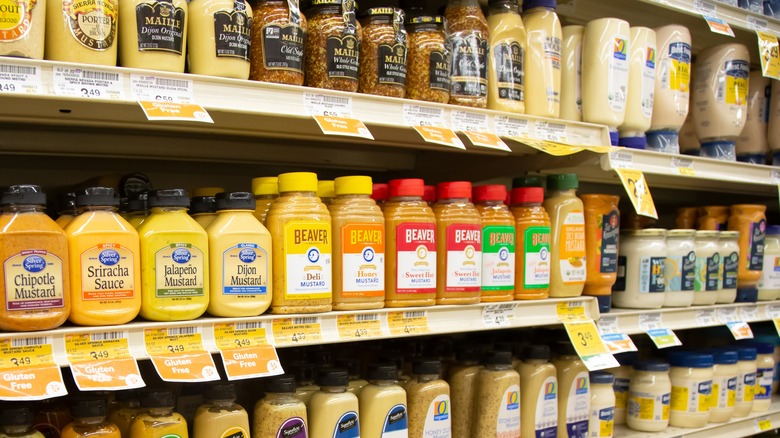Why You Should Be Mixing Mustards, According To Ina Garten
Mustard needs no introduction, yet chances are you have multiple bottles in your fridge and you don't know exactly what it's in the stuff. It's tangy, it's spicy, and it comes in different styles, all of which are different shades of brown and yellow. So why does celebrity chef Ina Garten condone mixing different mustards?
According to Britannica, mustard is a condiment made primarily using seeds from white, brown, or black mustard plants. MasterClass explains that all mustards are pastes made with mustard seeds, water, and an acidic component that helps temper its head-clearing "heat." Spiceography notes that the mustard plant has been revered for its medicinal and culinary uses since ancient times, and says it first became a popular food in Medieval Europe. Moreover, mustard was the go-to spice there until colonial contact with the Far East. The allure of mustard endures owing to its signature sharp flavor and how well it pairs with a wide variety of dishes.
Unlike many other spices, mustard is cultivated in cooler countries like the United States, Canada, England, and Hungary, (per Britannica). Perhaps that's one of the reasons why it's become one of the States' most beloved condiments. It can be used as a base in many recipes including meat rubs, dressings, and sauces, like those that Garten makes.
Ina Garten loves dijon mustard
Chef Ina Garten, aka the Barefoot Contessa, combines her dijon mustards to great effect. In a TODAY article, she reveals that Grey Poupon dijon mustard and Maille's whole grain Dijon are key ingredients in her dressings. You'll recognize dijon mustard by its gold-gray color, and it's made with brown mustard seeds and ground to a very fine consistency. Per MasterClass, it's the first mustard type to be regulated and now regularly utilizes white wine, which adds a specific character to foods. As its name suggests, dijon mustards originate in Dijon, France (per Taste France Magazine). France has been a true connoisseur of mustards since 10th-century monks first brought the condiment to Paris, Taste France Magazine continues.
Grey Poupon is a tangy, spreadable mustard and can be used on meats and vegetables, and as a secret ingredient in eggs benedict's hollandaise sauce. Maille mustard is known for its smoothness. The brand recommends pairing it with red meat and mac and cheese. It's the qualities of both of these mustards that make Garten's vinegarette so delicious.
Other mustard types and their uses
Dijon mustard is different than the yellow and spicy brown varieties, but just as useful. Ina Garten's crispy mustard-roasted chicken and mustard-roasted potatoes demonstrate Dijon's utility. Her chicken thighs with creamy mustard sauce recipe calls for both "good Dijon" and whole-grain mustard, and now you know the brands the chef favors. Whole grain mustard contains intact mustard seeds and makes a tasty dip for pretzels, cheeses, and smoked meats, with no cooking necessary. Then there's always Garten's creamy mustard vinaigrette, which is praised (per PBS News Hour) as "the one recipe everyone should know how to make." Its star ingredient? Dijon mustard and a little champagne vinegar.
Mustard is a healthy condiment, low in fat and calories, and Healthline reports that it contains vitamins, minerals, and antioxidants. Homemade sauces like Garten's are perfect for using up lingering mustard, just shake up all the ingredients right inside the bottle. It's handy to have around for humble weekday salads and showstopping roasted Cornish hens with orange-mustard glaze. And for kids, there's always fun and familiar yellow mustard and honey mustard, perfect for chicken nuggets.


